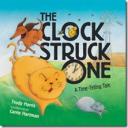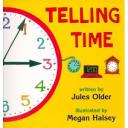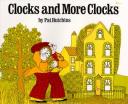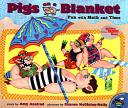Introduction to the topic-
This entry covers the topic of telling time. It focuses on VA SOL 2.12. The student will tell and write time to the nearest 5 minutes, using analog and digital clock. There are many great resources for teaching this subject to students, some are listed below.
Text annotations-
The Clock Struck One: A Time-telling Tale (Math Is Fun!) by: Trudy Harris
PreSchool-Grade 2€”A playful expansion of “Hickory, Dickory Dock,” this picture book centers around the concept of a cat chasing a mouse through the hours of a day. “Hickory dickory doo, the grandfather clock struck TWO./It woke the cat, who sprang from his mat,/hungry for mouse-tail stew,” and the race is on. Some of the rhyming verses are awkwardly constructed (“Hickory dickory date,/at EIGHT, they ran through the gate./The farmer’s son/said, ‘That looks fun./I’m coming too. So wait!'”). Expressive mixed-media illustrations display a gleeful mouse swinging on the clock chimes while a sleepy feline dozes on a nearby rug, and then highlight the ensuing chaos as other animals and people join the pursuit. The ending shows a very tired mouse and cat catching their breath as the clock strikes one in the morning. A thoughtful afterword offers a two-page explanation about the difference between digital and analog clocks and how to tell time, and challenges readers to find the various clocks featured in the illustrations (e.g., a cuckoo clock, a pocket watch, and a digital stove clock)- source www.amazon.com
Telling Time With Big Mama Cat by: Dan Harper
PreSchool-Grade 2-A feline claims, “Some people think cats don’t know much-but I, Big Mama Cat, know how to tell time. How else could I keep my busy day on schedule?” Readers quickly discover the irony in this assertion, as illustrations soon reveal that her busy day consists of napping, eating, or waiting to do one or the other. Her proprietary interest in the goings-on of her domain are manifest in her awareness of the humans’ schedule, from the morning rituals of baby feedings and the school bus to the family’s evening routine of dinner and a bedtime story. The simple, consistent arrangement of text and pictures on each page gently frames the humor and perfectly captures the everyday dramas of naptime and tea parties. Humor is furthered by visual details, including birds and mice of which the proud feline narrator seems completely unaware. Clocks showing the times noted in the text are clearly visible on every page and can be supplemented by a clock with moveable plastic hands that is part of the front cover. The tongue-in-cheek tone of the story and high-quality art are so engrossing, however, that the cover clock might be entirely ignored. Buy several copies; this combination is guaranteed to please those learning to tell time as well as their younger siblings.- source www.amazon.com
Telling Time: How to Tell Time on Digital and Analog Clocks by: Jules Older
Kindergarten-Grade 3-Beginning with a robust “TICK” and ending with an equally bold “TOCK,” Older acts as both an encouraging coach and cheerleader for youngsters learning about time. He defines the concept clearly, citing two meanings-when things happen and how long things take. After delving into how time can be broken down (from a second to a century), the author gets down to the nitty-gritty of telling time. He begins with the easier digital-clock face. Once that is thoroughly explained, he ponders the more difficult analog clock. Readers are taken through the process of reading it, and little tests are thrown in to keep students on track. Answers are given in the text, along with rewarding smiley faces. (“Yes! It’s seven-thirty. You deserve another smiley face!”) The cartoon illustrations, showing children and many, many types of clocks are colorful, plentiful, and inviting. A rather silly poem is appended to help readers remember how long things take: “Sixty seconds make a minute,/that’s a lot of seconds, innit?” Although a.m. and p.m. are discussed (“-breakfast is at six A.M., but supper is at six P.M.”) they are never really defined. Beyond these minuscule qualms, this jovial look at time and time telling is as handy as they come.- source www.amazon.com
Clocks and More Clocks by: Pat Hutchins
When the hall clock reads twenty minutes past four, the attic clock reads twenty-three minutes past four, the kitchen clock reads twenty-five minutes past four, and the bedroom clock reads twenty-six minutes past four, what should Mr. Higgins do? He can’t tell which of his clocks tells the right time. He is in for a real surprise when the Clockmaker shows him that they are all correct!- source www.amazon.com
Pigs on A Blanket by: Amy Axelrod
Grade 1-2 Children who exercised their math skills with the effervescent porcine family in Axelrod’s Pigs Will Be Pigs (S & S, 1994) can pick up more practice adding, subtracting, and telling time as the portly clan visits the beach. The piglets are ready to go in no time, but the minutes march past as Mr. Pig tries to find a swimsuit that still fits (45 minutes), hunts for car keys (1 hour), gets a speeding ticket (13 minutes), stands in line at the concession stand (60 minutes), and insists they wait for lunch to digest (30 minutes, plus 20 more for the lemonade and brownies). At last it’s “Time to ride the waves!” But no, it’s 5:30, and the beach is closing. Animal characters in colorful summer dress cavort cheerfully through simple cartoon illustrations. The Pigs’ misadventure gets a recap in rebuses at the end, and an afterword poses a few word problems and a discussion of clock face features and digital equivalents.- source www.amazon.com
Web annotations-
This website has an online quiz for telling time. Students should just click start to begin. The student is told if their answer is correct or incorrect. If incorrect, the correct answer is stated.
This website contains an online activity with time word problems. The word problems are related to activities that students might encounter at school. Students must enter the correct time. Includes a.m. and p.m.
In “Max’s Challenge”, students keep an online log of the activities they do in one hour and how many minutes each activity takes.
For this online game, students must find all the clocks showing the time stated. Self checker component is included!
This online activity allows students to enter a time on the digital clock and the face will move on the analog clock. A great practice tool.
Additional resources–
An online glossary of math terms. Students can look up terms such as hour, minute, second and use the definitions to make time flashcards. This flashcard maker could be used for students to type their definitions in.
A free online worksheet maker will allow teachers to make worksheets about time for use in their classroom. The site will also generate an answer key.
This board game activity would be a great classroom center activity. Game would be best for 2-4 players.
This site includes a list of power point presentations for teachers to use when teaching telling time . Presentations include many pictorial example slides.





